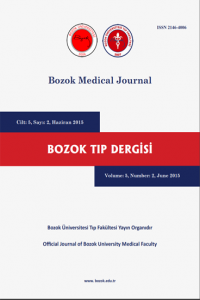Öz
Aim: The aim of this retrospective randomized study was to evaluate the effect of sutureless-mesh technique, which is used to repair inguinal hernia, on early and chronic complications and postoperative pain. Materials and Methods:. A total of 98 patients underwent inguinal hernia repair using the Lichtenstein and sutureless methods respectively. The patients were analyzed in two groups according to the surgical procedures, namely the Lichtenstein group (n = 46) and the sutureless mesh group (n = 52). The age and gender of patients, operation time, early complications and the long-term results (recurrence and pain) were evaluated. Results: There was no significant difference in age and gender between groups (p> 0.01). The mean duration of operation was 30.6 ± 3.72 minutes in the sutureless-mesh group and 45.3 ± 6.84 minutes in the Linchsteinstein group, which exerted statistically significant difference, (p <0.001). There was no statistical difference in terms of early complications and recurrence between the groups (p> 0.01). The mean VSA values were 2.0 ± 1.08 in the Sutureless-mesh group and 4.3 ± 1.62 in the Linchsteinstein group in the first week (p <0.001) , 1.7 ± 0.60 in the Sutureless-mesh group and 2.4 ± 1.45 in the Linchsteinstein group in the first month (p: 0.012) and finally 1.2 ± 0.41 in the Sutureless-mesh group and 1.5 ± 1.33 in the Linchsteinstein group during the first 12 months (p :0.145 ). Conclusion: The suturless-mesh method did not affect early and late postoperative complications. The results of our study indicated that the suturless-mesh method could be safely and effectively used for inguinal hernia repair.
Kaynakça
- REFERENCES
- Lichtenstein IL, Shulman AG, Amid PK, Montllor MM. The ‘tension-free’ hernioplasty. Am J Surg
- ; 157: 188–193
- Amid PK, Lichtenstein IL. Long-term results and current status of Lichtenstein open tension-free hernioplasty. Hernia 1998; 2: 89–94
- EU Hernia Triallists Collaboration. Mesh compared with non-mesh methods of open groin hernia repair: systematic review of randomized controlled trials. Br J Surg 2000; 87: 854–859
- Sajid MS, Leaver C, Baig MK, Sains P. Systematic review and meta-analysis of the use of lightweight versus heavyweight mesh in open inguinal hernia repair. Br J Surg 2012; 99: 29–37
- Campanelli G, Pascual MH, Hoeferlin A, Rosenberg J, Champault G, Kingsnorth A,et al. Randomized, controlled, blinded trial of Tisseel/Tissucol for mesh fixation in patients undergoing Lichtenstein technique for primary inguinal hernia repair: results of the TIMELI trial. Ann Surg 2012; 255: 650–657
- Amid PK, Shulman AG, Lichtenstein IL. Open ‘‘tensionfree’’ repair of inguinal hernias: the Lichtenstein technique. Eur J Surg 1996; 162: 447–453
- Downie WW, Leatham PA, Rhind VM, Wright V, Branco JA, Anderson JA.Studies with pain rating scales. Annals Rheumatic Diseases 37: 378-381, 1978
- Merskey H, Bogduk N,editors. Classification of chronic pain. Descriptions of chronic pain
- syndromes and definitions of pain terms. Prepared by the international association
- for the study of pain, task force on taxonomy. IASP Press, Seattle, 1994
- Klosterhalfen B, Junge K, Klinge U. The lightweight and large porous mesh concept for hernia repair. Expert Rev Med Devices 2005; 2: 103–117.
- O’Dwyer PJ, Kingsnorth AN, Molloy RG, Small PK, Lammers B, Horeyseck G. Randomized clinical trial assessing impact of a lightweight or heavyweight mesh on
- chronic pain after inguinal hernia repair. Br J Surg 2005; 92: 166–170.
- Paajanen H. A single-surgeon randomized trial comparing three composite meshes on chronic pain after Lichtenstein hernia repair in local anesthesia. Hernia 2007; 11: 335–339.
- Nikkolo C, Lepner U, Murruste M, Vaasna T, Seepter H, Tikk T. Randomised clinical trial comparing lightweight mesh with heavyweight mesh for inguinal hernioplasty. Hernia 2010; 14: 253–258.
- Post S, Weiss B,Willer M, Neufang T, Lorenz D. Randomized clinical trial of lightweight composite mesh forLichtenstein inguinal hernia repair. Br J Surg 2004; 91: 44–48.
- Callesen T, Bech K, Nielsen R, Andersen J, Hesselfeldt P, Roikjaer O, et al. Pain after groin hernia repair. Br J Surg. 1998; 85: 1412–1414.
- Fernández RL, García JS, Ortega PD, Martín FJL, Ruíz JC, Limones ME. Tissucol application in dermolipectomy and incisional hernia repair. Int Surg. 2001; 86: 240–245.
- Canonico S1, Santoriello A, Campitiello F, Fattopace A, Corte AD, Sordelli I,et al. Mesh fixation with human fibrin glue (Tissucol) in open tension-free inguinal hernia repair: a preliminary report. Hernia. 2005; 9: 330–333.
- Chatzimavroudis G, Papaziogas B, Koutelidakis I, Galanis I., Atmatzidis S., Christopoulos P, et al. Lichtenstein technique for inguinal hernia repair using polypropylene mesh fixed with sutures vs. self-fixating polypropylene mesh: a prospective randomized comparative study. Hernia. 2014; 18: 193-8.
- Chastan P. Tension-free open hernia repair using an innovative self-gripping semi-resorbable mesh. Hernia. 2009; 13:137–142.
- Garcia-Urena MA, Hidalgo M, Feliu X, Velasco MA, Revuelta S, Gutierrez R, et al. Multicentric observational study of pain after the use of a selfgripping lightweight mesh. Hernia. 2011; 15: 511–515
Ayrıntılar
| Bölüm | Orjinal Çalışma |
|---|---|
| Yazarlar | |
| Yayımlanma Tarihi | 1 Haziran 2015 |
| Yayımlandığı Sayı | Yıl 2015 Cilt: 5 Sayı: 2 |


